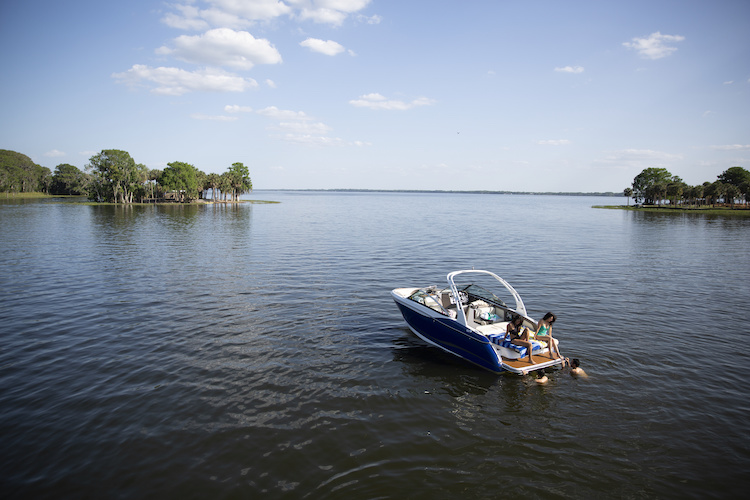Selling your boat is a big decision, but if you’ve already got your next new boat picked out (and if you don’t be sure to visit our Boat Finder Tool), in many cases you’ll have to part with the old one. Unfortunately, selling a boat can sometimes be a long process—but there are some tricks to follow to help speed up the sale. You say you want to know how to sell a boat quickly, and for top dollar?
Here are the basic steps to follow when selling your boat:
- Determine if you are going to sell the boat yourself, or work with a broker or dealer.
- Make sure the boat looks and runs as good as possible.
- Research the price of similar boats taking make, model, size, and age into consideration.
- Decide on an asking price.
- Advertise your boat for sale.
- Show the boat and seal the deal.
Working with Boat Brokers and Dealers
If you understand how to sell your boat, but you really don’t want to invest all the necessary time and effort, you can always enlist the help of a professional boat broker or dealer. Or, you could simply trade in your boat if you’re buying a new one from a dealer who accepts trades. Both options are easier than selling a boat yourself, but there are some pitfalls to either approach. Brokers will take a cut of the proceeds, and you rarely get anything like top dollar on a trade-in. To learn more about these options, be sure to read Trade-In or Sell Your Boat.
Trade-In or Sell Your Boat: What Are Your Options?

Preparing a Boat For Sale
The amount of prep work you do to your boat will have a dramatic impact on how much someone’s willing to pay for it. Remember, no one “needs” to buy a boat and it’s usually an emotional purchase. So you’re hoping for someone to fall in love with the boat at first sight.
That means cleaning the boat inside and out, and washing and waxing every inch of it. Even clean out those areas that are out of sight and out of mind, like stowage compartments under seats or the inside of a fishbox. If someone looks inside as they inspect the boat, you want them to see a neat, clean interior. Also remove any extra gear that amounts to clutter. This will help the boat’s deck, cabin, and/or stowage compartments seem larger at first glance.
Naturally, a potential buyer will also be interested in a boat that functions properly. Fix any broken or malfunctioning equipment—especially powerplants (engine)—prior to attempting to sell the boat, or you can’t expect to get top dollar.
Pricing Your Boat
Once it’s cleaned and prepped, you need to nail down a reasonable asking price for your boat. You can start by checking the NADA guides. But remember that the values they publish are estimates, at best. The boat’s condition will have a huge impact on its value, which those guides can’t take into account. So you should look at listings for similar boats online, in magazines, and at boat broker websites as well. As you do so, remember that the boat’s value will also be impacted by geography, and may bring a higher price in areas where boats are in high demand but a lower price in areas where they aren’t. The type of boating you’ve done also plays a role, since boats used in freshwater tend to bring higher prices than those used in saltwater. Even seasonality can affect boat pricing, because many people are more apt to buy a boat in the spring than in the late fall or winter.
After you settle on a figure, remember that a boat’s only worth what someone is willing to pay for it. If the price is too high it may sit on the market for months at a time. Since it can be so hard to nail down a value, some boat sellers list at a starting point and gauge the interest level for a month or so. Then they drop the asking price a few percent for each week or month that goes by after that, until a significant number of buyers begin to show interest.

How to Advertise a Boat For Sale
With the boat fully prepped and an asking price in mind, it’s time to start generating some leads. In this day and age most people advertise their boat on a number of different internet sites that offer classifieds. Some are free, some are not, and all offer unpredictable results. You may also want to advertise in a local paper or boating magazine. And don’t neglect the tried and true tactic of simply hanging a “For Sale” sign on the boat and placing it in a high-visibility area near a busy road or marina.
Showing the Boat
When a prospective buyer contacts you and shows some interest, you should be prepared to show him or her the boat and, if they’re still interested after an initial viewing, take them for a sea trial. You should also be prepared to show them documents confirming legal ownership, and the boat’s maintenance records. The most important thing during this stage of the process is to remember that honesty is the best policy. More than one boat sale has been stymied when a potential buyer realized the seller was being less than completely up-front with them.
If you and a buyer negotiate a deal and reach an agreement, you should be prepared with all the paperwork legally necessary to complete the transaction. This will vary from state to state (though at the very least it will involve signing over a title), and you should do the legwork ahead of time and have it all lined up. A buyer could change his or her mind after a handshake, but not after signatures and a financial transaction—so as the seller it’s up to you to make the process as smooth and speedy as possible.
Read Next: Trade-In or Sell Your Boat
Okay: let’s say the sale has been made, and your beloved old boat is off to its new home. Now you can turn your full attention to the more pressing issue—enjoying the brand-new boat you just bought!
Already searching for your next boat? Let us help!
Next Steps...
- Boat Buyer's Guide
- New or Used Boats: How to Decide Which Type of Boat to Buy
- Boat Financing Options
- Where & When to Buy a Boat
- Boat Owner's Guide
